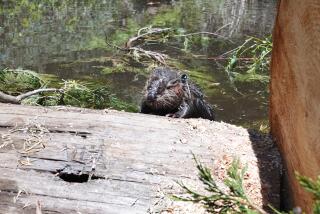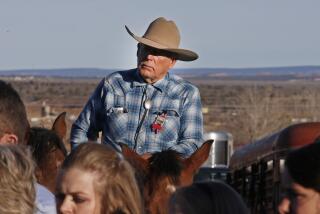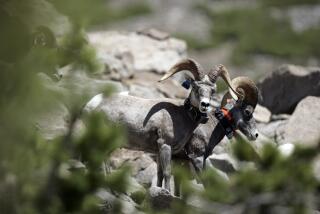Wayward Buffalo Roam on the Oregon Range
- Share via
MISSION, Ore. — The bison pause on a high, grassy ridge and gaze lazily at the humans in the field below -- but Carl Scheeler isn’t fooled.
A check of the massive trap nearby tells Scheeler that the herd has visited it and even wandered inside the rounded, open-air structure to munch on sweet hay and salt left as bait.
That’s encouraging news for Scheeler, who has spent the last few weeks scrambling to catch the buffalo. The 70-animal herd was released in mid-April by its owner, Robert Carey, before he fled to Mexico to avoid a water quality citation. Darrell Sallee, who owns the 20-acre plot where Carey kept his herd, can’t find him.
The herd, now down to 32 because of illegal hunting, at first wandered miles in the rolling hills outside Pendleton without interference. But when it made its way onto Umatilla tribal land, members said the bison were damaging crops, tearing through fences and scaring residents. Bison can weigh up to a ton, jump a six-foot fence from a standstill, and are skittish and easily enraged.
“Nobody was doing anything,” said Debra Croswell, spokeswoman for the tribes. “The state wasn’t doing anything and the landowner wasn’t in a position to do anything. So it fell into our laps.”
Scheeler, program director for the Tribal Wildlife Program, was assigned to the task and found himself taking a crash course on buffalo behavior.
What he learned from other tribes that manage bison -- primarily the Shoshone-Bannock in Idaho, the Yakama in Washington and the 51-member Intertribal Bison Cooperative -- wasn’t heartening.
“They told me that you can’t make buffalo go anywhere that they don’t want to go; they’re difficult at this time of year because of calving, and it’s difficult to bait them into a trap,” Scheeler said.
“And if you try to herd them with horses, the bulls will gore the horses. Any handling has to be done very gently and thoughtfully, to make them think that they had the idea. They’re not like cattle.”
The state Department of Fish and Wildlife offered Scheeler and his seven-member team the use of an elk trap, made of huge sheets of thick black plastic stretched over a round frame of metal beams. After a week spreading bait in an open field where Scheeler planned to set up the trap, his team began to erect it section by section. Next, Scheeler intends to hide in some nearby trees until the herd enters the enclosure and then pull the heavy door shut by a rope attached to an all-terrain vehicle.
It’s a dangerous and uncertain proposition.
“One of the biggest challenges is to get them all in the pen at once,” he said. “These animals have a very strong dominance hierarchy, and they tend to go crazy once part of their herd is missing. They’re extremely dangerous.”
Once the bison are in the pen, workers will have to sort the creatures by sex and load them into separate trucks through a narrow chute. If loaded together, the bulls would likely gore the cows to death, he said.
Scheeler is worried that if the first attempt fails, the tribe won’t have another opportunity for months.
“They’re very intelligent animals and if you push them too far, they’ll dig in their heels and you’re done for a while,” Scheeler said.
A backup plan could involve installing an electric fence around the herd while they sleep, he said. “But then you have the same problem -- how do you handle them?”
The tribe also isn’t sure what it will do with the bison once they’re captured. The tribe could auction off the animals or keep the herd as a tourist attraction at the Wildhorse Resort & Casino.
Some leaders have suggested maintaining it to honor the buffalo’s role in tribal history.
“We’ve got lots of oral histories about our people traveling up to what is now Montana to hunt buffalo,” said Croswell, the tribal spokeswoman.
More to Read
Sign up for Essential California
The most important California stories and recommendations in your inbox every morning.
You may occasionally receive promotional content from the Los Angeles Times.










